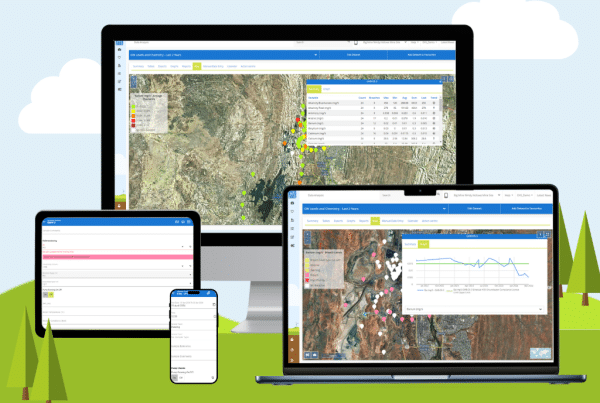How to Untangle the Data Management Jumble With MonitorPro
Managing environmental data can end up being a headache for many organisations because of mandatory requirements and the sheer volume of information. But there is a lot of value in good data that is properly evaluated. Some data collection activities are legal requirements, such as those contained in environmental permits. These impose conditions on an operation and force the enterprise to responsibly manage its environmental impacts. Such regulations require the permit holder to follow certain operational procedures and practices.
The Data Management jumble
“Our environmental data management is in a bit of a mess,” said the V.P. of Environment rather sheepishly.
Over the next couple of days, we began to look at his system. Historical data that was more than five years old had been archived but had at least been grouped into folders labeled land, air, surface water, effluent, and waste. Opening these folders revealed a large number of spreadsheets and databases, which were effectively gathering dust. Whilst there was lost value in that data from the viewpoint of historical trends and so on, that was not the main issue for the V.P.
Many types of current data was still being collected; groundwater (levels and quality), waste production, dust and other air quality variables from the emission stacks (VOCs, NOx, SOx, particulates), surface water, effluent quality, and flow rates, and weather. Data was also being collected on water use and recycling, fuel use (all sources) and the waste being recycled and landfilled.
Some of this data was manually collected, some resulted from the analysis by external labs and some was automatically collected from data loggers. Because the growth in data management had happened organically, different, and disparate, processes had evolved in parallel to deal with this. The processes were in part driven by the data source (e.g. the format in which data was provided by a lab or data logger) and in part by of the idiosyncrasies of the people involved.
The net result was that lots of people were doing lots of things but working inefficiently. Regular reporting of data was error-prone and reports were often late. The reporting process was a matter of cutting and pasting, sometimes from five different spreadsheets, to make a single report.
Our conclusion was that the V.P. was right – his data was in a mess and, without intervention, was likely to worsen. One such operational practice is usually an on-going monitoring program, with defined targets for many of the measured variables. The frequency of the monitoring can be anything from continuous (e.g. for dust, flow rates, vibration or weather), hourly, daily, weekly, monthly, quarterly, half-yearly, or annually. Breaches need to be addressed and reported to the control authority, sometimes within 24 hours of the incident.
Remedial measures need to be put in place, and repeated exceedances can, in extreme cases, result in prosecution, fines, or even withdrawal of permits or shutting down a facility. The data also needs to be reported internally and externally in differing formats and at regular intervals (monthly, quarterly, biannually, or annually).
In addition to statutory permits, other legislation is in place in many jurisdictions that obligate qualifying companies to collect and provide information on the release of pollution. Such legislation is driven by public pressure. Examples include:
- The United States’ Toxics Release Inventory, born from the Emergency Planning and Community Right to Know (EPCRA) legislation,
- Australia’s National Pollution Inventory (NPI),
- Canada’s National Pollution Release Inventory and
- The European Pollutant Release and Transfer Register (E-PRTR), which contains data reported annually from some 24,000 industrial facilities covering 65 economic activities.
With rising concerns over climate change, many countries have also committed some or all of their industries to mandatory reporting requirements on greenhouse gas emissions. This takes place through emissions trading schemes in Europe and North America. In Australia, the 2007 National Greenhouse Gas and Energy Reporting Act created a national framework for reporting emissions and obligated many companies to report. In each case, with slight differences, all affected companies need to collect and report similar data. With a growing international emphasis on greenhouse gas control, reporting requirements can only increase, while cap-and-trade schemes are liable to generate a strong market need for extreme accuracy.
In addition to legislatively driven data collection, some aspects of environmental data management are directly driven by immediate business performance. Many companies will instigate an environmental management system (EMS) to improve environmental performance and reduce costs. Examples include a reduction in energy use, or reduction of waste production or controlling water use. Other aspects will have a less tangible benefit, such as improved compliance and better relationships with regulators, but will nevertheless deliver a business benefit.
For many companies, an EMS will also dovetail into the broader process of sustainability and corporate social responsibility. This process has multiple definitions but, broadly speaking, centers on development that “meets the needs of the present [generation] without compromising the needs of future generations to meet their own needs.” Sustainability is broader than environmental data management and a company needs to develop its own key performance indicators. There are various guidelines as to how these should be developed, but in each case, companies need to collect and report on data.
The Data Management Task
All of this means people and companies need to collect, manage and report more data than ever before, often more than adhoc systems were ever meant to handle. Some of this comes from monitoring carried out by individuals, contractors and analytical laboratories. There have also been many advances in monitoring and data logging, but often the analysis and reporting of the data is carried out in Microsoft Excel or other basic software packages. This brings a whole range of problems, such as those for the vice president noted in the sidebar. As the data volume grows:
- How do managers know they are on top of all their monitoring and data collection?
- How can users more easily judge performance and compliance (e.g. with permit threshold)?
- How can data be shared?
- How can organisations regularly and efficiently produce their reports for internal or external bodies?
- How can users view historical trends in data over many years that are spread among a host of different systems or platforms?
- Can users defend their data and audit it?
- How much time does all this take?
- How many errors are in the system and can data be validated?
Many clients spend a good deal of money on data collection and collation – up to £350,000 at a single site – and yet they are not able to capture the full value. This means that staff is spending work time inefficiently crunching numbers. Turnover at such positions further creates problems as additional training is required. Reporting is often late and the system becomes error-prone, damaging relationships with regulators and other stakeholders.
Specialised Software Tools
Given these factors, using specialised software tools is becoming more popular among businesses. Companies currently using systems gain some of the following benefits:
- Manage all types of Environmental Compliance Monitoring data, including: Ground and Surface Water, Leachate, Discharges, Gas, Air, Dust, Soil, Noise, and more.
- Flexible and comprehensive compliance limit system
- Compliance and quality are rigorously checked
- Set any number of compliance targets for any monitoring data set
- Set targets for any variable or KPI calculated in the system
- Customise unique warning and internal levels to help prevent breaches
- Modifications of targets over time with integrity being retained
- ‘Smart’ validation of data to rule out unlikely or impossible data
- Immediate email notification of issues or breaches
- Full scheduling and planning capability alerts if compliance data is missing
- Routinely automated and ad-hoc Compliance Reports
- Regulators prefer secure and auditable systems such as MonitorPro
- Certified (and used by) the UK Regulator (Environment Agency) under their MCERTS Scheme
- A complete and flexible data management system able to manage all EHS Data centrally
- Automated Imports and validation save time
- Integrate with other systems such as LIMS, SAP or PI
- Wide range of interpretation tools
- Large volumes of varied data can be easily managed
Some software tools are very niche products that address certain well-defined problems. These include energy management software, which may also deal with greenhouse gases and enable users to verify their bills on the basis of what they have used, and groundwater modelling software. Others are focused more holistically on managing a large user-defined array of data, addressing automated import and quality checking of data, key performance indicator production, compliance, scheduling, and reporting.
Other systems, in turn, seek to create an entire EMS and would need to contain facilities for all the elements of an EMS (e.g. the schedule of impacts, objectives and targets, training, document management). Systems that deal with this approach are often sold on the basis of Return on Investment (ROI), which suggests it is the software itself that generates the return. But the software only administers the system; it is the actual implementation of the initiatives on the ground that generates ROI.
Choosing the right Software Tools for you
The choice for a potential purchaser comes down to specification and budget – what do you want to achieve and how much money is budgeted? These factors work in tandem, and an organisation may achieve a satisfactory result from the investment of perhaps £10,000 to £50,000, although of course they could spend up to six times that for a major corporate-wide system. So the message is to first understand what it is needed, starting with a few sensible questions to ask of any supplier:
- Can I see a demonstration of the product? – Often this happens surprisingly late in a process.
- How many other customers does the supplier have and can I speak to them? – Most credible companies should be more than happy to supply a list.
- How often is the system updated and how? – Continually improving a product and fixing bugs should be crucial from any credible company.
- What are the support arrangements?
- What are the licensing arrangements? – Perpetual licenses, annual licenses, Software as a Service (SaaS) or some other.
- How is the data handled? – Backup security, auditable, accidental deletions, etc.
- Does the software have any relevant accreditation?
The volume of environmental data across organisations is rapidly increasing, with many companies spending hundreds of thousands of dollars each year. It is important that the software applied is capable of capturing value from the data. The use of specialist software tools has the potential to enable companies to reduce cost, improve environmental performance, strengthen relationships with stakeholders, and reduce risk. There are many capable companies that offer differing software solutions. Companies wishing to invest in such tools should first determine their requirements and then fully engage with suppliers early in the process of software procurement.
About MonitorPro
The complete, professional environmental data monitoring solution, MonitorPro is the IT solution trusted by environmental teams worldwide to manage their environmental compliance and data collection. MonitorPro is a web-based or locally hosted solution for the collation of ALL sources of environmental data, where it is generated by loggers, laboratories, weather stations, calculations, or other data repositories. MonitorPro is the first EHS Software solution to receive an MCERTS accreditation from the Environmental Agency.
About EHS Data
EHS Data is a world leading UK based software company providing Environmental Data Management Solutions to over 1,000 sites in 40 countries worldwide. For over 20 years, our versatile software solution, MonitorPro, has helped organisations save time, improve planning, quality control, site analysis and reporting to manage environmental obligations and sustainability.
ISO 27001
EHS Data is ISO 27001 certified.
A Carbon Negative Business
In 2020, EHS Data attained Carbon negative status and is committed to maintaining this status each year.




